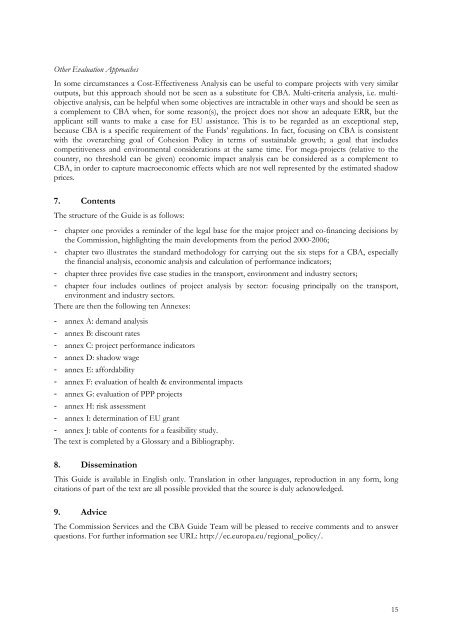Guide to COST-BENEFIT ANALYSIS of investment projects - Ramiri
Guide to COST-BENEFIT ANALYSIS of investment projects - Ramiri
Guide to COST-BENEFIT ANALYSIS of investment projects - Ramiri
Create successful ePaper yourself
Turn your PDF publications into a flip-book with our unique Google optimized e-Paper software.
Other Evaluation ApproachesIn some circumstances a Cost-Effectiveness Analysis can be useful <strong>to</strong> compare <strong>projects</strong> with very similaroutputs, but this approach should not be seen as a substitute for CBA. Multi-criteria analysis, i.e. multiobjectiveanalysis, can be helpful when some objectives are intractable in other ways and should be seen asa complement <strong>to</strong> CBA when, for some reason(s), the project does not show an adequate ERR, but theapplicant still wants <strong>to</strong> make a case for EU assistance. This is <strong>to</strong> be regarded as an exceptional step,because CBA is a specific requirement <strong>of</strong> the Funds’ regulations. In fact, focusing on CBA is consistentwith the overarching goal <strong>of</strong> Cohesion Policy in terms <strong>of</strong> sustainable growth; a goal that includescompetitiveness and environmental considerations at the same time. For mega-<strong>projects</strong> (relative <strong>to</strong> thecountry, no threshold can be given) economic impact analysis can be considered as a complement <strong>to</strong>CBA, in order <strong>to</strong> capture macroeconomic effects which are not well represented by the estimated shadowprices.7. ContentsThe structure <strong>of</strong> the <strong>Guide</strong> is as follows:- chapter one provides a reminder <strong>of</strong> the legal base for the major project and co-financing decisions bythe Commission, highlighting the main developments from the period 2000-2006;- chapter two illustrates the standard methodology for carrying out the six steps for a CBA, especiallythe financial analysis, economic analysis and calculation <strong>of</strong> performance indica<strong>to</strong>rs;- chapter three provides five case studies in the transport, environment and industry sec<strong>to</strong>rs;- chapter four includes outlines <strong>of</strong> project analysis by sec<strong>to</strong>r: focusing principally on the transport,environment and industry sec<strong>to</strong>rs.There are then the following ten Annexes:- annex A: demand analysis- annex B: discount rates- annex C: project performance indica<strong>to</strong>rs- annex D: shadow wage- annex E: affordability- annex F: evaluation <strong>of</strong> health & environmental impacts- annex G: evaluation <strong>of</strong> PPP <strong>projects</strong>- annex H: risk assessment- annex I: determination <strong>of</strong> EU grant- annex J: table <strong>of</strong> contents for a feasibility study.The text is completed by a Glossary and a Bibliography.8. DisseminationThis <strong>Guide</strong> is available in English only. Translation in other languages, reproduction in any form, longcitations <strong>of</strong> part <strong>of</strong> the text are all possible provided that the source is duly acknowledged.9. AdviceThe Commission Services and the CBA <strong>Guide</strong> Team will be pleased <strong>to</strong> receive comments and <strong>to</strong> answerquestions. For further information see URL: http://ec.europa.eu/regional_policy/.15




